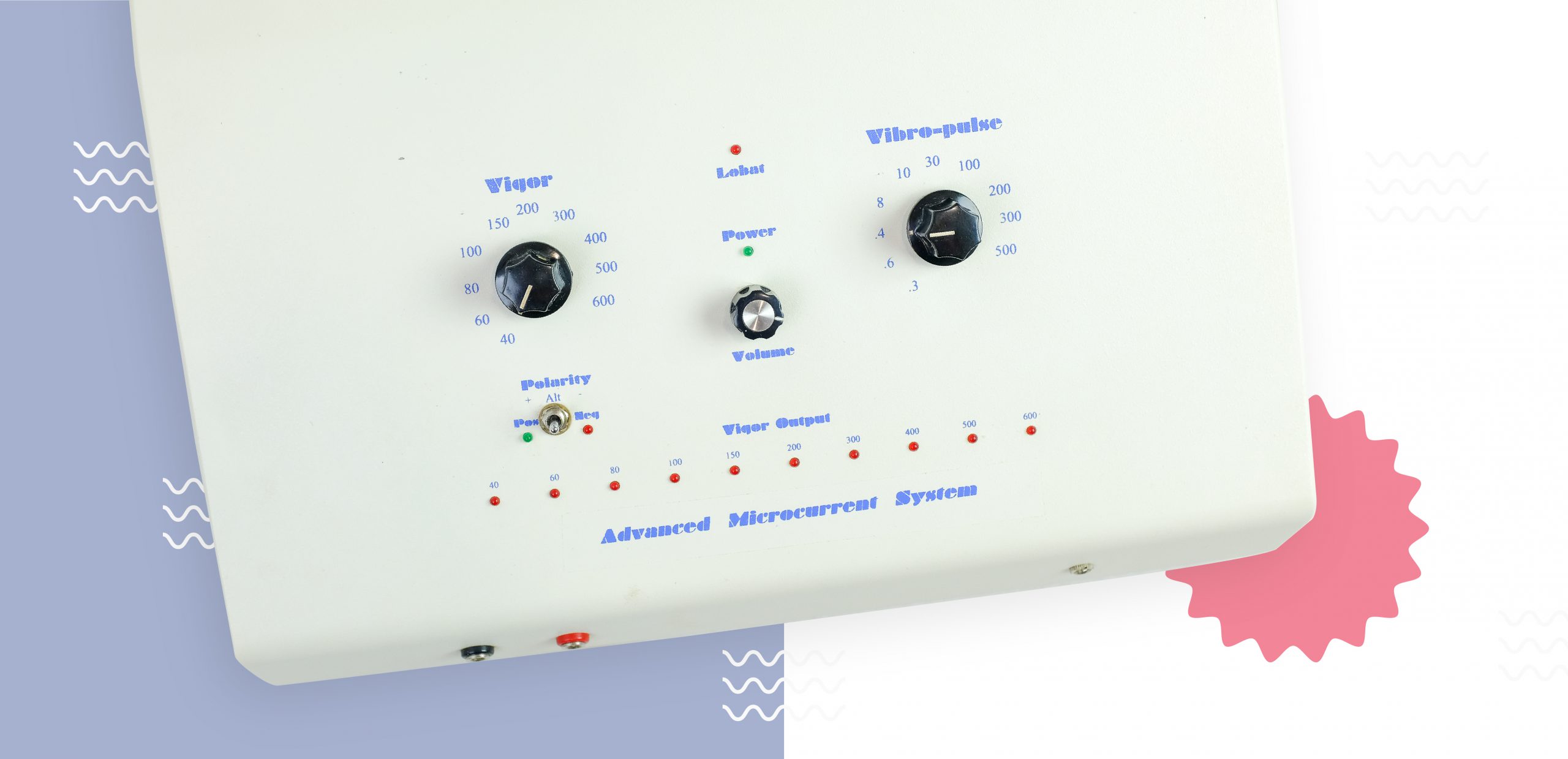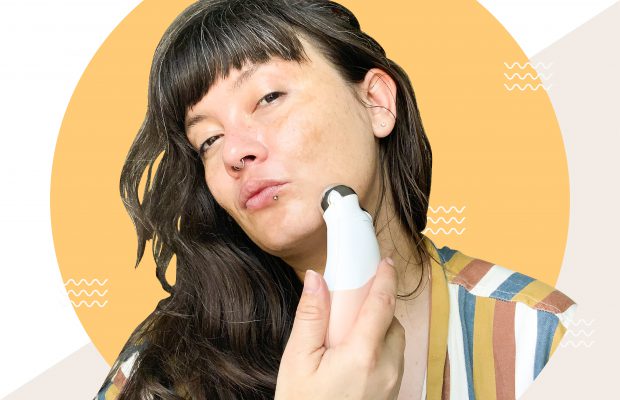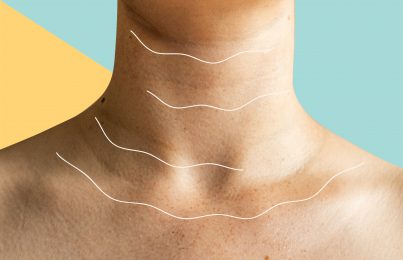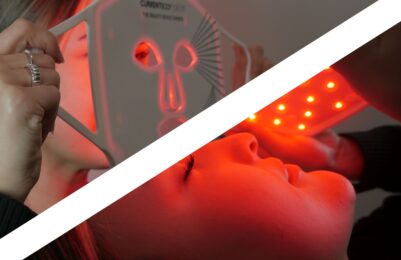Microcurrent technology has been around for decades but with the ever-growing popularity of at-home devices, you may be wondering whether a microcurrent device is worth your time and money. After 30 years of using microcurrent, it’s something I can definitely vouch for! Keep reading to learn about the benefits of using a microcurrent device and whether or not it’s right for you.
My Personal Experience With Microcurrent
I started using microcurrent technology back in the early 90s just a few years into my career as an esthetician. At that time, it was only available to professionals through what was known as an“electrical muscle stimulation machine.”
I liked the results I saw from using microcurrent on clients from the get-go, but I really became aware of its amazing muscle-strengthening abilities when I used it on a client who had developed Bell’s Palsy. Bell’s Palsy is a condition that causes temporary weakness or paralysis of facial muscles, making just one side of the face droop. I suggested to my client we start microcurrent treatments on the one side of her face where it had been paralyzed in order to strengthen and re-train the muscles in her face. The muscles (as well as her skin) rebounded soooooo quickly that even her doctor was shocked and started sending me many of his patients experiencing Bell’s Palsy!
Here’s a picture of one of the first commercially available microcurrent machines, and I was proud to be an early adopter!

This particular machine was created by Carol Cole, who later co-founded NuFace with her daughter, Tera. They popularized at-home microcurrent treatments with the NuFace Trinity, which is the device I use on myself at home. There are more microcurrent devices available now from brands like Foreo and Ziip, but this is the OG and the one I have personal experience with.
I’m such a believer in this type of technology that I’ve even incorporated NeuFit, an advanced type of electrical stimulation therapy, into my body workouts three times a week. It takes my workouts to the next level and has been really beneficial for helping me strengthen my body’s muscles without putting a lot of wear and tear on my tendons and joints. Some companies (NuFace in particular) sell at-home microcurrent devices for the body as well. These aren’t geared toward workouts like the machine that my trainer uses on me, but they can be great for firming and toning the skin on the body.
How Does Microcurrent Work, and What Will It Do for Me?
Microcurrent is a low-level electrical current meant to simulate the currents that naturally run through your body. The waves it gives off are able to penetrate through your skin and into your muscles. Because microcurrent works to strengthen muscles, it’s often described as a “workout for your face.”
Short-term benefits
In the short-term, using a microcurrent device can help temporarily lift and define the face. Because of this, I loved using it on my clients when I would give them a facial right before a big event. It’s also great for de-puffing, making the skin look tighter, and improving circulation by bringing blood flow to the face.
Long-term benefits
Just like when you work out the muscles in your body, the result of using microcurrent over time is firmer, toned skin with fewer visible wrinkles. In some cases, it can help define certain facial features like cheekbones and the jawline. Additional benefits include increased production of collagen and ATP (a molecule that carries energy to your cells).
If you’re looking for a little more definition in the face, it can be an alternative to filler because it promotes volume. The results won’t be as dramatic, of course, but may allow you to hold off on injections. Some practitioners even recommend using a microcurrent device if you’ve had Botox. This helps exercise the muscles and keep blood and nutrients flowing to them so they don’t atrophy or get “lazy.”
At-Home vs. Professional Microcurrent
The difference between at-home and professional microcurrent devices is simple—professional devices are stronger. While this may sound like an argument against at-home devices, I encourage you to think of it this way: a series of smaller workouts done consistently will always give better results than doing intense workouts sporadically. Because microcurrent hinges on consistency for good results, it’s the perfect technology for an at-home device.
Are At-Home Microcurrent Devices Suitable for Everyone?
Microcurrent devices are generally safe for everyone to use (the NuFace has even been approved by the FDA). That said, there are some precautions to keep in mind.
Skin conditions
If you have lots of active breakouts (red, inflamed acne), you may want to skip the microcurrent for now. Microcurrent is a very “active” treatment in that it stimulates your skin’s metabolism. While this is great for anti-aging purposes, acne is a sign that someone’s skin is already very metabolically active. Adding in more stimulation could potentially backfire, making the situation worse. If you get breakouts only occasionally you should be fine to use microcurrent, just avoid using the device directly on active blemishes. (Read about how an overly stimulating professional treatment caused this beauty editor’s sudden breakout.)
Similarly, if you have rosacea or very sensitive, redness-prone skin, try using your device on the lowest setting to avoid overstimulation.
Medical conditions
You should not use a microcurrent device if you have a history of epilepsy or seizures, have active cancer, or have a pacemaker or electronic implanted device. It also should not be used during pregnancy, but can safely be used while breastfeeding.
Age
Anyone over 18 can safely use an at-home microcurrent device, but I usually recommend people start using one in their late 20s or early 30s. The skin’s natural metabolism starts to slow down a bit at this point, so there’s less of a risk of overstimulating your skin. In addition, I believe microcurrent is best used as a preventative aging treatment (it’s better at preventing sagging than reversing it), so this is really a great time to start.
How Do I Use a Microcurrent Device With My Skincare Routine?
The cool thing about a microcurrent device is that it can complement your existing skincare routine to give you additional results above and beyond just topical products. While a well-rounded routine (including sunscreen) for your skin type should always be your first defense against visible skin aging, microcurrent takes it a step further by addressing the muscle underneath. Think of this as the scaffolding for your skin. By keeping the foundation strong, you help support the skin on top.
Be consistent
Just like any other workout for your muscles, microcurrent will only yield long-term results if you use it consistently. How often you use your device will depend on the brand and the results you’re looking for. Check with the manufacturer, but most brands recommend using your device anywhere from 10-20 minutes three to five times a week.
Use the right primer
In order for microcurrent waves to actually penetrate your skin and reach the muscle, it requires a water-based conductive primer. If you don’t use this, it’ll feel like you’re being zapped (it doesn’t hurt, but it also doesn’t feel good—trust me!). Most gel products are a good option since they’re inherently water-based. You can use something like Rapid Response Detox Masque. That said, most brands carry their own priming gel and claim it enhances the performance of their device, so you may want to double-check with the brand that makes your device.
Use it at the right time in your routine
If you’re using your microcurrent device during your regular skincare routine, I suggest doing it after you wash your face. It can be done either morning or evening, depending on when you have time. Apply your conductive gel and perform your microcurrent treatment. Then, rinse off the gel and proceed with the rest of your skincare routine, starting with toner. (Btw, this is the order you should be applying your skincare products in.)
If you’re using your microcurrent device during an at-home facial, cleanse your skin and do your exfoliating peel before using your device. The conductive gel will act as a hydrating mask and work better after you’ve removed dry, dead cell buildup from the surface of your skin.
I know microcurrent devices are an investment, so I hope my expert tips and personal experience help you make an informed decision! Read more about which skincare tools and devices I think are worth the money (and which ones aren’t).
Celebrity Esthetician & Skincare Expert
As an esthetician trained in cosmetic chemistry, Renée Rouleau has spent 35 years researching skin, educating her audience, and building an award-winning line of products. Her hands-on experience as an esthetician and trusted skin care expert has created a real-world solution — products that are formulated for nine different types of skin so your face will get exactly what it needs to look and feel its best. Trusted by celebrities, editors, bloggers, and skincare obsessives around the globe, her vast real-world knowledge and constant research are why Marie Claire calls her “the most passionate skin practitioner we know.”



